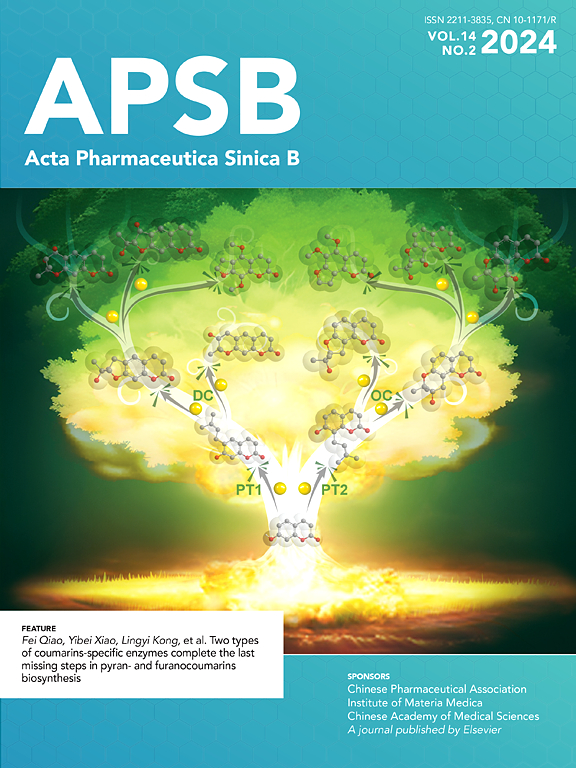耐药突变和血脑屏障:脑转移性非小细胞肺癌靶向治疗的关键挑战
IF 14.6
1区 医学
Q1 PHARMACOLOGY & PHARMACY
引用次数: 0
摘要
在过去的二十年中,使用EGFR-、ALK-、ROS1-和krasg12c靶向抑制剂治疗非小细胞肺癌(NSCLC)患者取得了显著进展。非小细胞肺癌患者经常发生脑转移。尽管不断开发出更新更好的抑制剂,但脑转移的NSCLC患者的生存结果仍明显差于无脑转移的患者。这些药物治疗的主要挑战是耐药突变的发展,以及潜在的血脑屏障(BBB)的存在。临床研究结果表明,下一代靶向抑制剂的疗效有所改善。使用这些后代抑制剂治疗的患者无进展生存期(PFS)的增加主要归因于它们对多种耐药突变的疗效,也可能是由于增强的脑穿透。本综述探讨了阻碍NSCLC靶向治疗的不同方面,特别是脑转移,重点关注最近的临床试验和新出现的耐药突变,以及血脑屏障对EGFR、ALK、ROS1和KRASG12C抑制剂疗效的影响。由于临床前研究表明,ABCB1和ABCG2药物转运体可能降低转运抑制剂的功效,因此还讨论了ABCB1和ABCG2药物转运体在靶向药物在血脑屏障的不同外排中的作用。本文章由计算机程序翻译,如有差异,请以英文原文为准。

Resistance mutations and the blood–brain barrier: Key challenges in targeted treatment of brain metastatic non-small cell lung cancer
Over the past two decades, marked progress has been made in treating non-small cell lung cancer (NSCLC) patients with EGFR-, ALK-, ROS1- and KRASG12C-targeted inhibitors. NSCLC patients very often develop brain metastases. Despite the continuous development of newer and better inhibitors, the survival outcomes of NSCLC patients with brain metastases remain significantly worse than those of patients without. The main challenges in these pharmacotherapies are the development of resistance mutations, and, potentially, the presence of the blood–brain barrier (BBB). The outcomes of clinical studies show the improved efficacy of later-generation targeted inhibitors. The increase in progression free survival (PFS) in patients treated with these later-generation inhibitors is largely attributed to their efficacy against multiple resistance mutations, and possibly due to enhanced brain penetration. This review explores the different aspects hindering the targeted treatment of NSCLC and especially of brain metastases, focusing on recent clinical trials and emerging resistance mutations and the influence of the BBB on the efficacy of EGFR, ALK, ROS1 and KRASG12C inhibitors. The role of the ABCB1 and ABCG2 drug transporters in differential efflux of the targeted drugs at the BBB is also discussed, since preclinical studies indicate that they may reduce the efficacy of transported inhibitors.
求助全文
通过发布文献求助,成功后即可免费获取论文全文。
去求助
来源期刊

Acta Pharmaceutica Sinica. B
Pharmacology, Toxicology and Pharmaceutics-General Pharmacology, Toxicology and Pharmaceutics
CiteScore
22.40
自引率
5.50%
发文量
1051
审稿时长
19 weeks
期刊介绍:
The Journal of the Institute of Materia Medica, Chinese Academy of Medical Sciences, and the Chinese Pharmaceutical Association oversees the peer review process for Acta Pharmaceutica Sinica. B (APSB).
Published monthly in English, APSB is dedicated to disseminating significant original research articles, rapid communications, and high-quality reviews that highlight recent advances across various pharmaceutical sciences domains. These encompass pharmacology, pharmaceutics, medicinal chemistry, natural products, pharmacognosy, pharmaceutical analysis, and pharmacokinetics.
A part of the Acta Pharmaceutica Sinica series, established in 1953 and indexed in prominent databases like Chemical Abstracts, Index Medicus, SciFinder Scholar, Biological Abstracts, International Pharmaceutical Abstracts, Cambridge Scientific Abstracts, and Current Bibliography on Science and Technology, APSB is sponsored by the Institute of Materia Medica, Chinese Academy of Medical Sciences, and the Chinese Pharmaceutical Association. Its production and hosting are facilitated by Elsevier B.V. This collaborative effort ensures APSB's commitment to delivering valuable contributions to the pharmaceutical sciences community.
 求助内容:
求助内容: 应助结果提醒方式:
应助结果提醒方式:


